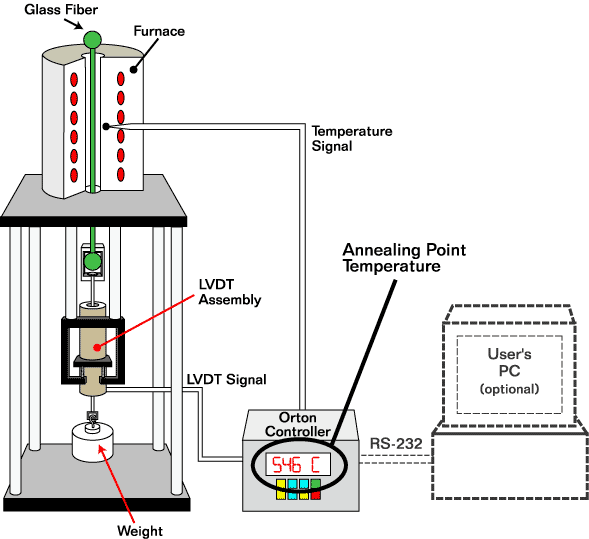|
|
|
¡¡ SP-2A-DAS (Glass Annealing & Strain Point) |
|||||||||||||||||||||||||||||||||||||||||||||
|
The Orton Model SP-2A-DAS has been designed to automatically monitor the elongation of a loaded sample fiber and calculate the annealing and strain points according to the ASTM C-336 (Method A). Changes in the annealing and strain point temperatures can be used as an indication of changes in batch chemistry from raw material changes or batching errors. Automatic Annealing and Strain Point
Determination  The system is initially heated to an equilibrium
soak temperature 25¡ÆC below the expected annealing point, and waits for
the next test. After the fiber is inserted and the weight applied, the
START button is pushed and the Orton controller heats the furnace at 5¨¬C
per minute. The temperature and LVDT signals of the elongating fiber are
captured by the controller¡¯s on board computer, where the elongation
rate is calculated and monitored. Once the elongation rate exceeds 0.60
millimeters per minute, the Orton controller cools the furnace at 4¡ÆC
per minute. While the furnace is cooling, the temperature and LVDT
signals are captured by the controller¡¯s on board computer for
storage. Once the elongation rate falls below 0.10 millimeters per
minute, the test is concluded and the annealing point temperature
(elongation rate of 0.14 millimeters / minute) is displayed on the
console display until the system is reset. The furnace automatically
cools to the soak temperature in about 15 minutes, and is ready for the
next test. The on board computer can store data for up to 10 tests.
The system is initially heated to an equilibrium
soak temperature 25¡ÆC below the expected annealing point, and waits for
the next test. After the fiber is inserted and the weight applied, the
START button is pushed and the Orton controller heats the furnace at 5¨¬C
per minute. The temperature and LVDT signals of the elongating fiber are
captured by the controller¡¯s on board computer, where the elongation
rate is calculated and monitored. Once the elongation rate exceeds 0.60
millimeters per minute, the Orton controller cools the furnace at 4¡ÆC
per minute. While the furnace is cooling, the temperature and LVDT
signals are captured by the controller¡¯s on board computer for
storage. Once the elongation rate falls below 0.10 millimeters per
minute, the test is concluded and the annealing point temperature
(elongation rate of 0.14 millimeters / minute) is displayed on the
console display until the system is reset. The furnace automatically
cools to the soak temperature in about 15 minutes, and is ready for the
next test. The on board computer can store data for up to 10 tests.If desired, a separate, independent computer system (not included) can be connected to the Orton controller console via a RS232 port for real time monitoring and analysis. During the test the fiber elongation rate, time, and temperature are displayed on the monitor and stored on the hard drive in a text file. At the conclusion of the test, the software automatically and immediately calculates the annealing point temperature (elongation rate of 0.14 millimeters / minute) and the extrapolated strain point temperature (elongation rate 0.0316 times the annealing point rate, or 0.004424 millimeters / minute) according to the ASTM C336 algorithms. Or, if preferred, a separate, independent computer system (not included) can be connected to the Orton controller console via a RS232 port after the test is concluded. The data stored by the Orton on board computer is transferred to the independent computer¡¯s hard drive in text file format for later independent review, analysis, or permanent storage. Model SP-2A-DAS Specifications
*Descriptions & specifications are subject to change without notice Manual Annealing and Strain Point Measurement
Instruments Model SP-2A System This is the original system to manually
perform the measurements. The temperature of the ASTM specified furnace
is controlled manually with a Variac. Using a telemicroscope mounted on
an independent stand, the operator manually observes the fiber
elongation against an independently supported scale, and manually
records that elongation along with the temperature. The operator
manually plots the data points and picks the annealing and strain point
temperatures from the graph. This is a modified version of the original SP-2A design. It uses an LVDT attached to the bottom of the fiber to sense the elongation. The telemicroscope and scales are not required. The operator manually records the LVDT readings and temperatures, and plots the data on a graph to pick the annealing and strain point temperatures from that graph.
*Descriptions & specifications are subject to change without notice |
|||||||||||||||||||||||||||||||||||||||||||||
|
|
|
Copyright 2001 Red Corona All rights reserved |